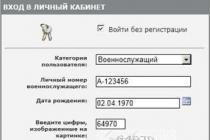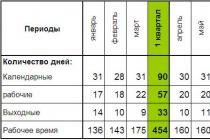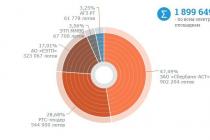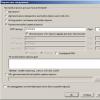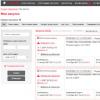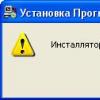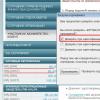Almost everyone has encountered an asynchronous motor. They are installed in a large number household appliances, as well as a working power tool. However, some of the motors are connected only through a three-phase wire.
Asynchronous motors are reliable and practical motors that are used everywhere. They are quiet and perform well. This article will show the basic principles of operation of three-phase electric motors, a connection diagram to a 220V network, as well as various tricks when working with them.
Most asynchronous motors operate on a three-phase network, therefore, we will initially consider the concept of three-phase current. A three-phase current or a three-phase system of electrical circuits is a system consisting of three circuits in which electromotive forces (EMF) of the same frequency act, phase shifted relative to each other by 1/3 of the period (φ = 2π / 3) or 120 °.
Most industrial generators are built on the basis of three-phase current generation. Basically, they use three alternators that are spaced 120 ° relative to each other.
The three-generator circuit assumes that 6 wires will be output from this device (two for each alternator). However, in practice, it is clear that household and industrial networks come to the consumer in the form of three wires. This is done to save wiring.
The coils of the generators are connected in such a way that the output turns out 3 wires, and not 6. Also, this switching of the windings generates a current with a power of 380V, instead of the usual 220V. It is such a three-phase network that all users are used to seeing.
INFORMATION: The first three-phase current system on six wires was invented by Nikola Tesla. Later it was improved and developed by M.O.Dolivo-Dobrovolskiy, who was the first to propose a four and three-wire system, and also conducted a series of experiments, where he revealed a number of advantages of this switching.
Most asynchronous motors operate on a three-phase network. Let's take a closer look at how these units work.
Asynchronous motor device
Let's start with the internal architecture of the motor. Externally, the device of a three-phase asynchronous motor is practically no different from other electric motors. Perhaps the only difference that catches your eye is the thicker power cord. The main differences are hidden from the eyes of the consumer under the metal casing of the motor.
Opening the control box (the place where the power wires go), you can see 6 wire entries. They are connected in two ways, depending on what characteristics need to be obtained from a given motor. More details on the methods of switching three-phase asynchronous motors will be described below.
By removing the protective metal casing, you can see the working part of the motor. It consists of:
- shaft;
- bearing assemblies;
- stator;
- rotor.
The main components of the motor are the stator and the rotor. It is they who set the engine in motion.
Let's analyze the structure of these components in a three-phase asynchronous motor:
- Stator. It is in the form of a cylinder, usually composed of steel sheets. Along the sheets, there are longitudinal grooves in which the stator windings, made of a winding wire, are located. The axes of each winding are located relative to each other at an angle of 120 °. The ends of the windings are connected by the delta or star method.
- Rotor or motor core. It is a cylindrical assembly made of metal plates, between which aluminum rods are located. The structure is short-circuited along the edges of the cylinder with end rings. The second name of the rotor of an induction motor is a squirrel cage. In high power engines, copper can be used instead of aluminum.
Now it is worthwhile to figure out on what principles the operation of an asynchronous three-phase motor is built.
Principles of operation of three-phase asynchronous motors
A three-phase induction motor works by magnetic fields that are created on the stator windings. The currents passing through each winding are offset by 120 ° relative to each other in time and space. Thus, the total magnetic flux on the three circuits is rotating.
A closed electrical circuit is formed on the stator windings. She interacts with magnetic field stator. This is how the starting torque of the engine appears. It tends to turn the rotor in the direction of rotation of the stator magnetic field. Over time, the starting torque approaches the value of the braking torque of the rotor, after which it exceeds it and the rotor is set in motion. At this moment, the sliding effect occurs.
INFORMATION: Slip is a value that shows how much the synchronous frequency of the stator magnetic field is greater than the rotor speed, as a percentage.
Consider this parameter in different situations:
- Idling. With no load on the shaft, slip is at a minimum.
- With increasing load. With an increase in static stress, the slip increases and can reach a critical value. If the motor exceeds this value, the motor may "overturn".

The slip parameter ranges from 0 to 1. For induction motors general purpose this parameter is 1-8%.
When there is an equilibrium between the electromagnetic torque of the rotor and the braking torque on the motor shaft, the processes of fluctuations in values stop.
With the onset of equilibrium between the electromagnetic moment, which causes the rotor to rotate and the braking moment created by the load on the shaft, the processes of changing the values will stop. It turns out that the basic principle of operation of an induction motor is the interaction of the rotating magnetic field of the stator and the currents that are induced by this magnetic field in the rotor. It should be borne in mind that the torque arises only as a result of the difference in the frequency of rotation of the magnetic fields on the motor windings.
Knowing the principle of operation of an asynchronous three-phase motor, you can start it. In this case, it is worth considering several options for connecting the motor windings.
Ways to connect the windings of asynchronous motors
Having unrolled the control unit of two simple induction motors, you can see 6 wire leads in each of them. However, their commutation can vary significantly.
In electrical engineering, it is customary to connect the windings of three-phase asynchronous motors in two ways:
- star;
- triangle.
Each type of connection affects the performance of the engine as well as its peak power ratings. Let's consider each of them separately.

Star method
In this type of switching, all outputs of the working windings are connected by one jumper into one node. It is called the neutral point and is denoted by the letter "O". It turns out that the ends of all phase windings will be connected in one place.
In practice, star-coupled motors have a smoother starting. This combination is suitable, for example, for lathes or other technology where a slow start is required. However, this engine cannot develop the maximum rated power.
Triangle method
This switching assumes a series connection of the ends of the phase windings. On the leads of the wires, it looks like a pairwise connection of each winding. It turns out that the end of one winding goes to the beginning of the other.
Motors with this winding connection start much faster than star-switched motors. At the same time, they can develop the maximum power provided by the manufacturer.
Three-phase asynchronous motors are designed based on the rated supply voltage. In particular, all domestic engines are divided into two categories:
- for 220 / 127V networks;
- for 380 / 220V networks.
Motors of the first group are less common due to their weak power characteristics. The motors of the second group are most often used.
IMPORTANT: When switching the motor windings, the rule is used: for lower voltage values, the connection is chosen using the delta method, for high - only the star method.
Some avid radio amateurs can determine the motor connection scheme by the sound of its start. The average person can learn about the commutation method of motor windings in several ways.
How to determine in what way the motor windings are connected?
The method of commutation of the motor winding affects its performance, however, all terminal connections are located under a protective casing in the control unit. They are simply not visible, but do not despair. There is a method that allows you to find out the switching method without having to disassemble the control unit.
To do this, just look at the number plate installed on the engine housing. It marks the exact technical specifications, including the switching method. For example, the following designations can be found on it: 220 / 380V and geometric designations of a triangle / star. This sequence indicates that a star-type winding switching circuit is installed on the motor operating from a 380V network.
but this way doesn't always work for sure. Plates on old engines are often overwritten or completely lost. In this case, you will have to untwist the control unit.
The second method involves visual inspection of the output contacts. The contact group can be connected in the following way:
- One jumper on three contacts on one side of the terminals. The supply wire is connected to the free terminal. This is the star method.
- The outputs are connected in pairs by three jumpers. Three power wires come to three pins. This is the triangle method.
On some motors, only three leads can be found in the control unit. This indicates that the commutation is made inside the motor itself, under the protective casing.
Three-phase motors are very hardy and are appreciated in households, repairs and construction. But they are useless for home use, since a household network can give only one phase, with a voltage of 220V. In fact, this is not entirely correct judgment. It is possible to connect a three-phase asynchronous motor to a household network. This is done using a radio component - a capacitor. Let's take a closer look at this method.
Phase shift with capacitors

Motors that use capacitors are called capacitor motors. The capacitor itself is installed in the stator circuit so that it creates a phase shift in the windings. Often this scheme used when connecting three-phase asynchronous motors to a 220V household network.
To shift the phases, you will need to connect one of the windings to the gap with the capacitor. In this case, the capacitance of the capacitor is selected in such a way that the phase shift on the windings is as close as possible to 90 °. In this case, the maximum torque is created for the rotor.
IMPORTANT: In this diagram, it is necessary to take into account the modules of the magnetic induction of the windings. They must be the same. This will create a total magnetic field that will rotate the rotor in a circle rather than an ellipse. In this case, the rotor will spin more efficiently.
The optimal phase shift is achieved by the correct selection of the capacitance of the capacitor, both in the starting and in the operating mode. Also, the correct circular magnetic field depends on:
- rotor speed;
- mains voltage;
- the number of turns of the winding;
- connected capacitors.
If the optimal value of one of the parameters deviates from the norm, then the magnetic field becomes elliptical. The quality of the engine will drop immediately.
Therefore, to solve different types tasks are selected by motors with different capacitor capacities. To ensure the maximum starting torque, take a capacitor with a larger capacity. It provides optimal current and phase during motor starting. In the case when the starting torque does not matter, attention is paid only to creating the necessary conditions for the operating mode.
How to connect a three-phase electric motor to a 220 V network?
Consider the simplest way to connect a three-phase asynchronous motor to a household network. This will require a set of hand tools, a capacitor, as well as a minimum knowledge of electrical engineering and a multimeter.
So, step by step guide by connection:
- We spin the engine control unit and look at the connection diagram. If the star method is used, it is necessary to twist the commutation into a delta.
- The connection is made only on one side of the winding leads. For convenience, we will designate them from 1 to 3.
- We connect a capacitor to the 1st and 2nd outputs.
- On the 1st and 3rd outputs we put 220V power wires. In this case, we do not touch pin 2. Only the capacitor remains on it.
- We turn on the power wire to the network and check the operation of the engine.
IMPORTANT: The calculation of the capacitor power is carried out according to the formula: per 100W / 10 μF.
This method is very simple and safe. Before connecting the capacitor and pre-starting the engine, it is worth checking the integrity of the wiring circuit for penetration through the body. This can be done with a multimeter.
As you can see, the scheme is quite simple. The connection will not take long and will require a minimum of effort. There are other schemes for connecting a three-phase motor to a regular network. Let's consider them as well.
INFORMATION: Unfortunately, not all three-phase motors work well on a household network. Some may simply burn out. These include motors with a double cage squirrel-cage rotor (MA series). To use three-phase motors in a household network, it is better to use motors of the AO2, APN, UAD, A, AO series.
Connection diagram of three-phase motors in a single-phase network

For a safe and correct work a three-phase induction motor from a household network must use a capacitor. Moreover, its capacity should depend on the number of revolutions of the motor.
In practical implementation this device to make is quite problematic. To solve this problem, two-stage motor control is used. Thus, at the time of start-up, two capacitors are operating:
- launcher (Cn);
- worker (Wed).
After the engine has set operating speed, the starting capacitor is turned off.
Consider a motor connection diagram using two capacitors.
In this version, it is assumed that the engine is used in a 220 / 380V network. Scheme:
Legend: Ср - working capacitor; Cn - starting capacitor; P1 - packet switch.
When the packet switch P1 is turned on, the contacts P1.1 and P1.2 are closed. At this moment it is necessary to press the "Acceleration" button. When the engine reaches operating speed, the button is released. The engine is reversed by switching the SA1 toggle switch.
Consider several formulas for connecting windings using different methods:
- For the "star" method. Formula: Avg = 2800 * (I / U); where Cp is the capacity of the working capacitor (μF), I is the current consumed by the electric motor in (A), the voltage in the network (V).
- For the "triangle" method. Formula: Avg = 4800 * (I / U); where Cp is the capacity of the working capacitor (μF), I is the current consumed by the electric motor in (A), the voltage in the network (V).
For any switching method, the current consumed by the electric motor is calculated. Formula: I = P / (1.73Uŋ * cosϕ); where P is the engine power in W, indicated in its passport; ŋ - efficiency; cosϕ is the power factor; U is the voltage in the network.
In this scheme, the capacity of the starting capacitor Cn is selected 2-2.5 times higher than the capacity of the working capacitor. In this case, all capacitors must be rated for a voltage 1.5 times higher than the mains voltage.
INFORMATION: For household 220V networks, capacitors such as MBGO, MBPG, MBGCH with an operating voltage of 500V and above are well suited. For short-term connection, capacitors K50-3, EGTs-M, KE-2 are used as starting ones. Moreover, their operating voltage should be at least 450 V. For greater reliability, electrolytic capacitors are connected in series, connecting their negative terminals, and shunted with diodes
The use of electrolytic capacitors as starting
To connect three-phase asynchronous electric motors to a household network, as a rule, simple paper capacitors are used. Per long time they have not shown themselves in the best way, so now large paper capacitors are practically not used. They were replaced by oxide (electrolytic) capacitors. They have smaller dimensions and are widely used in the radio component markets. Consider the scheme for replacing a paper capacitor with an oxide one:
It can be seen from the diagram that a positive AC wave passes through the elements VD1, C2, and a negative one through VD2, C2. This suggests that these capacitors can be used with an allowable voltage 2 times lower than that of conventional capacitors of similar capacity. The capacitance for an oxide capacitor is calculated using the same method as for paper capacitors.
INFORMATION: So in the circuit of a single-phase 220V network, a paper capacitor with a voltage of 400V is used. When replacing it with an oxide capacitor, a power of 200V is sufficient.

Series and parallel connection of capacitors
It is worth noting that a motor connected to a 220V household network, without much load, will suffer from one of the windings. This is a circuit that connects through a capacitor. In this case, it receives a current that is 20-30% higher than the nominal one. From this it follows that on an underloaded motor, the capacitance of the capacitor must be reduced. But then, if the engine was started without a starting capacitor, the latter may be required.
Replacing one large capacitor with several, connected in a circuit in a parallel way, will help to solve this problem. So you can connect or disconnect unnecessary components using capacitors as starting ones. With a parallel connection, the total capacitance in μF is calculated by the formula: Ctot = C1 + C1 + ... + Cn.

Required tools and accessories
Any installation of the above circuits will require minimal knowledge of electrical engineering, as well as skills in working with radio electronics and soldering small parts.
Of the tools you will need:
- A set of screwdrivers for collecting / disassembling the engine control unit. For older engines, it is better to select powerful flat screwdrivers made of good steel. Over a long period of engine operation, the bolts in the housing can "stick". Unscrewing them will require a lot of effort and a good tool.
- Pliers for crimping wires and other manipulations.
- A sharp knife for stripping the insulation.
- Soldering iron.
- Rosin and solder.
- Indicator screwdriver for phase detection and cable break indication.
- Multimeter. One of the main diagnostic devices.

You will also need radio parts:
- Capacitors.
- Start button.
- Magnetic switch.
- Reverse toggle switch.
- Contact board.
The listed tools and radio components are enough to assemble the above circuits.
IMPORTANT: Do not plug the motor into the mains without checking the operation assembled circuit... It can be tested with a multimeter. This will save the equipment from a short circuit.
Conclusion
A three-phase asynchronous motor is a reliable and efficient motor that can be connected to both three-phase and single-phase networks. In this case, it is necessary to follow a number of rules. In particular, it is necessary to correctly calculate the capacitance of the capacitors. If all calculations are correct, the engine will run optimally with high level Efficiency.
The need to use a three-phase asynchronous electric motor independently most often arises when home-made equipment is installed or designed. Usually, in dachas or in the garage, craftsmen want to use homemade emery machines, concrete mixers, tools for sharpening and trimming products.
Using three-phase asynchronous motor by yourself
Here the question arises: how to connect an electric motor designed for 380 to a 220 volt network. In addition, it is important both to connect the electric motor to the network, and to provide the necessary indicator of the coefficient of performance (COP), to maintain the efficiency and operability of the unit.
Features of the engine device
Each motor has a plate or nameplate where the technical data and the winding twisting diagram are indicated. Y stands for star connection and ∆ for delta connection. In addition, the plate indicates the mains voltage for which the electric motor is intended. The wiring for connecting to the network is located on the terminal block, where the winding wires are led out.
To designate the beginning and end of the winding, the letters C or U, V, W are used. The first designation was in practice earlier, and English letters began to be used after the introduction of GOST.

It is not always possible to use a motor intended for a three-phase network for operation. If 3 outputs are brought to the terminal block, and not 6 as usual, then the connection is possible only with the voltage indicated in the engineering specifications. In these units, a delta or star connection has already been made inside the device itself. Therefore, it is not possible to use a 380 Volt 3-pin motor for a single-phase system.
You can partially disassemble the engine and convert 3 pins to 6, but this is not so easy to do.
There are different schemes of how best to connect devices with parameters of 380 volts to a single-phase network. To use a three-phase electric motor in a 220 Volt network, it is easier to use one of 2 connection methods: "star" or "triangle". Although it is possible to start a three-phase motor with 220 without capacitors. Let's consider all the options.
The figure shows how this type of connection is made. In the operation of the electric motor, you should additionally use phase-shifting capacitors, which are also called starting (Descent) and working (Sat.).

Star connection type
In a star connection, all three ends of the winding are connected. For this, use a special jumper. Power is supplied to the terminals from the beginning of the windings. In this case, the beginning of the winding C1 (U1) goes through parallel connected capacitors to the beginning of the winding C3 (U3). Next, this end and C2 (U2) must be connected to the network.
In this type of connection, as in the first example, capacitors are used. In order to connect the twists according to this scheme, 3 jumpers are required. They will connect the beginning and end of the winding. The conclusions coming from the beginning of the C6C1 winding through the same parallel circuit as in the case of the "star" connection are connected to the output coming from C3C5. Then the resulting end and the output of C2C4 should be connected to the network.

Connection type "Triangle"
If 380 / 220VV indicators are indicated on the nameplate, then connection to the network is possible only according to the "triangle".
How to calculate capacity
For a working capacitor, the formula is applied:
Srab. = 2780хI / U, where
U - rated voltage,
I - current.
There is another formula:
Srab. = 66xP, where P is the power of a three-phase electric motor.
It turns out that the 7μF capacitance of the capacitor is designed for 100W of its power.
The value for the capacity of the starting device should be 2.5-3 orders of magnitude more than the working one. Such a discrepancy in capacitance indicators for capacitors is required, because the starting element is turned on when a three-phase motor is operating for a short time. In addition, when turned on, the highest load on it is much greater, it is not worth leaving this device in the operating position for a longer period, otherwise, due to phase current imbalance, after a while the electric motor will start to overheat.
If you use an electric motor for operation, the power of which is less than 1 kW, then the starting element is not required.
Sometimes the capacity of one capacitor is not enough to start work, then the circuit is selected from several different elements connected in series. The total capacity in parallel connection can be calculated using the formula:
Ctot = C1 + C1 +… + Cn.
In the diagram, a similar connection looks like this:

It will be possible to understand how correctly the capacitors' capacities are selected only in the process of use. Because of this, a scheme of several elements is more justified, because with a larger capacity, the engine will overheat, and with a smaller one - output power will not reach the desired level. It is better to start the selection of capacity with its minimum value and gradually bring it to the optimal one. In this case, you can measure the current using a current measuring pliers, then select the best option will become easier. A similar measurement is made in the operating mode of a three-phase electric motor.
Which capacitors to choose
To connect an electric motor, paper capacitors (MBGO, KBP or MPGO) are most often used, but they all have small capacitive characteristics and are quite bulky. Another option is to choose electrolytic models, although here you will have to additionally connect diodes and resistors to the network. In addition, when the diode breaks down, and this happens quite often, an alternating current will flow through the capacitor, which can lead to an explosion.
In addition to capacity, you should pay attention to the operating voltage in the home network. In this case, you should select models with technical indicators of at least 300W. For paper capacitors, the calculation of the operating voltage for the network is slightly different, and the operating voltage of of this type devices must be above 330-440VV.
Network connection example
Let's see how this connection is calculated using an example of a motor with the following characteristics on the nameplate.

Engine characteristics
So, let's take a three-phase asynchronous motor with a connection diagram for a 220 Volt network with a "triangle" and a "star" for 380 Volts.
In this case, the power of the electric motor taken for example is 0.25 kW, which is much less than 1 kW, a starting capacitor is not required, and the general scheme will look like this.

To connect to the network, you need to find the capacity of the working capacitor. To do this, you should substitute the values in the formula:
Srab. = 2780 2A / 220V = 25 μF.
The operating voltage of the device is selected above 300 volts. Based on this data, the corresponding models are sorted. Some options can be found in the table:
Dependence of capacitance and voltage on the type of capacitor
| Condenser type | Capacitance, μF | Rated voltage, V |
|---|---|---|
| MBG0 | 1 2 4 10 20 30 | 400, 500 160, 300, 400, 500 160, 300, 400 160, 300, 400, 500 160, 300, 400, 500 160, 300 |
| MBG4 | 1; 2; 4; 10; 0,5 | 250, 500 |
| K73-2 | 1; 2; 3; 4; 6; 8; 10 | 400, 630 |
| K75-12 | 1; 2; 3; 4; 5; 6; 8; 10 | 400 |
| K75-12 | 1; 2; 3; 4; 5; 6; 8 | 630 |
| K75-40 | 4; 5; 6; 8; 10; 40; 60; 80; 100 | 750 |
Thyristor key connection
A three-phase electric motor designed for 380 volts is used for single-phase voltage using a thyristor switch. In order to start the unit in this mode, you need this diagram:

Three-phase electric motor diagram for single-phase voltage
The work used:
- transistors from the VT1, VT2 series;
- resistors MLT;
- silicon diffusion diodes D231
- thyristors of the KU 202 series.
All elements are rated for 300 Volts and 10A.
A thyristor key is assembled, like other microcircuits, on a board.
Anyone who has the initial knowledge in creating microcircuits can make such a device. When the power of the electric motor is less than 0.6-0.7kW, when the thyristor switch is connected to the network, heating of the thyristor switch is not observed, therefore additional cooling not required.
Such a connection may seem too complicated, but it all depends on what elements you have in order to convert a 380W motor into a single-phase one. As you can see, using a three-phase motor for 380 through a single-phase network is not as difficult as it seems at first glance.
Connection. Video
The video tells about the safe connection of emery to a 220 V network and shares advice on what is needed for this.
We are going to consider how a three-phase motor is connected to a single-phase network, to give recommendations on how to control the unit. More often than not, people want to vary the rotation speed or direction. How to do it? They described vaguely earlier how to connect a three-phase 230 volt motor, now we will attend to the details.
Standard scheme for connecting a three-phase motor to a single-phase network
The process of connecting a three-phase motor to 230 volts is simple. Usually the branch carries a sinusoid, the difference is 120 degrees. A uniform phase shift is formed, ensuring smooth rotation of the stator electromagnetic field. The effective value of each wave is 230 volts. This will allow the three-phase motor to be plugged into a household outlet. Circus trick: get three sinusoids using one. The phase shift is 120 degrees.
In practice, this can be done with the help of special phase shifter devices. Not those that are used by high-frequency paths of waveguides, but special filters formed by passive, less often active elements. Fans of troubles prefer the use of a filling capacitor. If the motor windings are connected with a triangle, forming a single ring, we get phase shifts of 45 and 90 degrees, at least enough for the unsteady operation of the shaft:
Wiring diagram for a three-phase motor by switching windings with a delta
- The phase of the socket is fed to one winding. The wires catch the potential difference.
- The second winding is powered by a capacitor. A phase shift of 90 degrees relative to the first is formed.
- On the third, due to the applied voltages, a slightly sinusoidal oscillation is formed with a shift of another 90 degrees.
In total, the third winding is 180 degrees apart from the first in phase. Shows practice, the layout is enough to work normally. Of course, the engine sometimes "sticks", gets very hot, the power drops, the efficiency is lame. Users are reconciled when the connection of an asynchronous motor to a three-phase network is excluded.
From purely technical nuances, let's add: a diagram of the correct layout of the wires is shown on the body of the device. More often it decorates the inner side of the casing that hides the shoe, or is drawn nearby on the nameplate. Guided by the diagram, we will understand how to connect an electric motor with 6 wires (a pair for each winding). When the network is three-phase (often called 380 volts), the windings are connected in a star. A single point common to the coils is formed, where the neutral is joined (conditional circuit electrical zero). Phases are fed to the other ends. It turns out three - according to the number of windings.
How to handle the triangle for connecting a three-phase 230 volt motor is clear. In addition, we present a figure depicting:
- Diagram of the electrical connection of the windings.
- A working capacitor serving the purpose of creating the correct phase distribution.
- Starting capacitor, which facilitates shaft spinning at initial speed. Subsequently, it is disconnected from the circuit with a button, discharged by a shunt resistor (for safety and being ready for a new start cycle).

Connecting a three-phase 230 volt delta motor
The picture shows: winding A is at 230 volts. On C it is fed with a phase shift of 90 degrees. Due to the potential difference, the ends of winding B generate a voltage that is shifted 90 degrees. The outlines are far from the sinusoid familiar to school physicists. The starting capacitor and shunt resistor are omitted for the sake of simplicity. We believe that the location is obvious from the above. A similar technique, at the very least, will make it possible to achieve from the engine normal work... With the key, the starting capacitor closes, carrying out a start, disconnects from the phase, and is discharged by a shunt.
It's time to say: the capacitance indicated by the drawing of 100 μF is practically selected, taking into account:
- Shaft rotation frequencies.
- Engine power.
- Loads on the rotor.
You need to select a capacitor experimentally. According to our figure, the voltage of windings B and C will be the same. Reminder: the tester shows the actual value. The voltage phases will be different, the waveform of winding B is non-sinusoidal. The effective value shows: the same power is given to the shoulders. Bole less stable operation of the installation is provided. The motor heats up less, the efficiency of the motor is optimized. Each winding is formed by an inductive reactance, which also affects the phase shift between voltage and current. This is why it is important to select the correct capacitance value. Ideal engine operating conditions can be achieved.
Make the engine spin in the opposite direction

Three phase voltage 380 volts
When connected to three phases, the reversal of the direction of rotation of the shaft is ensured by correct switching of the signal. Special contactors are used (three pieces). 1 for each phase. In our case, only one circuit is subject to commutation. Moreover (guided by the assertions of the guru) it is enough to swap any two wires. Whether it is power supply, the place of docking of the capacitor. Let's check the rule before issuing parting words to readers. The results are shown in the second figure, which schematically shows the diagrams showing the distribution of the phases of the indicated case.
Making the diagrams, it was assumed: winding C is connected in series with a capacitor, which gives the voltage a positive phase increase. According to the vector diagram, to maintain balance, winding C must have a negative sign relative to the main voltage. On the other hand, the capacitor, coil B are connected in parallel. One branch provides the voltage with a positive increase (capacitor), the other - current. Akin to a parallel oscillatory circuit, the currents of the branches flow in almost the opposite direction. Considering the above, we adopted the law of changing the sinusoid in antiphase with respect to the winding C.
The diagrams show: the maxima, according to the diagram, bypass the windings counterclockwise. The previous review showed a similar context: the rotation is going in a different direction. It turns out that when the polarity of the power supply is changed, the shaft rotates in the opposite direction. We will not draw the distribution of magnetic fields, we consider it unnecessary to repeat.
More precisely, such things will allow you to calculate special computer programs... The explanation was given on the fingers. It turned out that the practitioners are right: by changing the polarity of the power supply, the direction of the shaft movement is reversed. Surely a similar statement is suitable when a capacitor is switched on by a branch of another winding. For those who are hungry for detailed charts, we recommend that you study specialized software packages like the free Electronics Workbench. In the application, put down the desired number of control points, track the laws of change in currents and voltages. Those who like to make fun of their brain will be able to view the spectrum of signals.
Take the trouble to set the winding inductance correctly. Of course, the load that prevents the launch is introduced. It is difficult to account for losses with such programs. Practitioners recommend avoiding focusing on the specified sharpener, selecting capacitor ratings (empirically) empirically. Thus, the exact connection diagram of a three-phase motor is determined by the design assumed intended purpose... Let's say a lathe differs from a bread machine by developing loads.
Three-phase motor starting capacitor
More often, the connection of a three-phase motor to a single-phase network must be carried out with the participation of a starting capacitor. Especially the aspect concerns powerful models, motors under significant load at the start. In this case, the intrinsic reactance increases, which will have to be compensated for by means of capacitors. Easier to pick up again experimentally. It is necessary to assemble a stand, on which it is possible to "hot" switch on, exclude individual containers from the circuit.
Avoid helping the engine to start by hand, as “seasoned” technicians demonstrate. Just find the value of the battery at which the shaft rotates vigorously, as you spin, begin to exclude capacitors from the circuit one by one. Until there is such a set, below which the engine does not rotate. The selected elements form the starting capacity. And the correctness of your choice must be monitored with a tester: the voltage in the arms of the phase-shifted windings (in our case, C and B) should be the same. This means that approximately equal power is delivered.

Three-phase motor with starting capacitor
As for the estimates and estimates, the battery capacity grows with the increase in power, speed. And if we talk about the load, it has a big impact at the start. When the shaft spins, in most cases small obstacles are overcome by inertia. The more massive the shaft, the higher the chance that the engine will not "notice" the problem.
Please note that the connection of an asynchronous motor is usually carried out through circuit breaker... A device that will stop rotation when the current exceeds a certain value. This not only protects the plugs of the local network from burnout, but also saves the motor windings when the shaft is jammed. In this case, the current will rise sharply and the operation of the device will stop. A circuit breaker is also useful when selecting the required capacity rating. Eyewitnesses claim that if a 3-phase motor is connected to a single-phase network through capacitors that are too weak, then the load increases sharply. In the case of a powerful motor, this is very important, because even in normal mode, the consumption exceeds the nominal by 3-4 times.
And a few words about how to estimate in advance starting current... Let's say you need to connect an asynchronous 230 motor with a power of 4 kW. But this is for three phases. In the case of standard wiring, the current flows through each of them separately. For us, all this will add up. Therefore, we boldly divide the power by the mains voltage and we get 18 A. It is clear that without load such a current is unlikely to be consumed, but for the stable operation of the engine to its fullest, a protective circuit breaker of tremendous power is needed. As for a simple test run, a 16 ampere device will do quite well. And there is even a chance that the start will take place without incidents.
We hope the readers now know how to connect a three-phase motor to home network at 230 volts. It remains to add to this that the capabilities of a standard apartment do not exceed the value of about 5 kW in terms of power output to the consumer. This means that the engine described above at home is simply dangerous to turn on. Please note that even grinders are rarely more powerful than 2 kW. In this case, the engine is optimized for operation in a single-phase 220 volt network. Simply put, too powerful devices will not only cause the light to blink, but most likely provoke other abnormal situations. In the best case, it will knock out the plugs, in the worst case, the wiring will catch fire.
On this we say goodbye and want to note: knowledge of theory is sometimes useful for practitioners. Especially when it comes to powerful technology that can cause considerable harm.
The article is devoted to the possibility of starting a 250 W three-phase asynchronous motor from a 220 V network not using a starting capacitor, but using a homemade starting electronic device. Its circuit is very simple: on two thyristors, with thyristor switches and transistor control.
Device diagram

Few people know this motor control and is practically not used. The advantage of the proposed starter is that the loss of engine power is significantly reduced. When starting a three-phase 220 V motor with a capacitor, the power loss is at least 30%, and can reach 50%. The use of this starter reduces the power loss to 3%, with a maximum of 5%.


A single-phase network is connected:

The starter is connected to the motor instead of the capacitor.

A resistor connected to the device allows you to control the engine speed. The device can also be switched to reverse.

For the experiment, an old Soviet-made engine was taken.

With this starter, the engine starts instantly and runs without any problems. This circuit can be used on almost any engine up to 3 kW.
Note: in a 220 V network, it simply does not make sense to turn on motors with a power of more than 3 kW - household wiring will not withstand the load.
In the circuit, you can use any thyristors, the current of which is not less than 10 A. Diodes 231, also 10-ampere.
Note: the author has 233 diodes in the circuit, which does not matter (only they run at a voltage of 500 V) - you can put any diodes that have a current of 10 A and hold more than 250 V.
The device is compact. The author of the circuit assembled resistors simply in sets, so as not to waste time selecting resistors at face value. No heat sink required. A capacitor, a zener diode, two 105 diodes are installed. The circuit turned out to be very simple and effective in operation.

Recommended for use - assembling the launcher will not create problems. As a result, when connected, the engine starts at its maximum power and practically without its loss, in contrast to the standard circuit using a capacitor.
Asynchronous electric motors are widely used in industry due to their relative simplicity of design, good performance, and ease of control.
Such devices often fall into the hands of a home craftsman and he, using his knowledge of the basics of electrical engineering, connects such an electric motor to operate from a single-phase 220 volt network. Most often it is used for emery, woodworking, grinding of grains and other simple tasks.
Even on individual industrial machine tools and mechanisms with drives, there are samples of various motors capable of operating from one or three phases.
Most often, they use capacitor starting, as the simplest and most acceptable, although this is not the only way known to most literate electricians.
The principle of operation of a three-phase motor
Industrial asynchronous electrical devices 0.4 kV systems are available with three stator windings. Voltages are applied to them, angularly shifted by 120 degrees and causing currents of a similar shape.
To start the electric motor, currents are directed in such a way that they create a total rotating electromagnetic field that optimally affects the rotor.
The stator design used for this purpose is represented by:
1. body;
2. the magnetic core of the core with three windings laid in it;
3. terminal leads.

In the usual design, the insulated winding wires are star-wired by installing jumpers between the terminal screws. In addition to this method, there is also a connection called a triangle.

In both cases, the windings are assigned a direction: beginning and end, associated with the method of installation - winding during manufacture.
The windings are numbered with Arabic numerals 1, 2, 3. Their ends are designated K1, K2, K3, and the beginning - H1, H2, H3. For certain types of engines, this marking method can be changed, for example, C1, C2, C3 and C4, C5, C6 or other symbols, or not at all.

Correctly applied markings make it easy to connect the power wires. When creating a symmetrical voltage arrangement on the windings, the creation of rated currents is ensured, which carry out the optimal operation of the electric motor. In this case, their shape in the windings fully corresponds to the supplied voltage, repeats it without any distortion.

Naturally, it should be understood that this is a purely theoretical statement, because in practice currents overcome various resistances, deviate slightly.
The visual perception of the ongoing processes is helped by the image of vector quantities on the complex plane. For a three-phase motor, the winding currents generated by the applied symmetrical voltage are depicted as follows.

When the electric motor is powered by a system of voltages with three evenly spaced angles and vectors of the same magnitude, the same symmetric currents flow in the windings.
Each of them forms an electromagnetic field, the induction force of which induces its own magnetic field in the rotor winding. As a result of the complex interaction of the three fields of the stator with the field of the rotor, a rotational movement of the latter is created, the creation of the maximum mechanical power that rotates the rotor is ensured.
Principles of connecting a single-phase voltage to a three-phase motor
For a full connection to three identical stator windings spaced 120 degrees apart, there are no two voltage vectors, there is only one of them.
You can put it in just one winding and make the rotor spin. But, effectively using such an engine will not work. It will have very low shaft power output.
Therefore, the problem arises of connecting this phase in such a way that it creates a symmetrical system of currents in different windings. In other words, you need a voltage converter from a single-phase network to a three-phase one. This problem is solved by different methods.
If we discard the complex circuits of modern inverter installations, then the following common methods can be implemented:
1.use of capacitor start;
2. the use of chokes, inductive resistances;
3. creation of different directions of currents in the windings;
4. combined method with equalization of phase resistances for the formation of equal amplitudes for currents.
Let's take a quick look at these principles.
Current deviation when passing through the container
The most widely practiced capacitor start, which allows you to deflect the current in one of the windings by connecting a capacitive resistance, when the current is advanced from the vector of the applied voltage by 90 degrees.
As capacitors, metal-paper structures of the MBGO, MBGP, KBG series and the like are usually used. Electrolytes are not suitable for the passage of alternating current, they quickly explode, and the circuits providing for their use are complex, low reliability.

In this circuit, the current differs in angle from the nominal value. It deviates only 90 degrees, not reaching 30 degrees (120-90 = 30).
Current deviation when passing through an inductor
The situation is similar to the previous one. Only here the current lags behind the voltage by the same 90 degrees, and thirty is short. In addition, the choke design is not as simple as that of a capacitor. It must be calculated, assembled, adjusted to individual conditions. This method is not widely used.

When using capacitors or chokes, the currents in the motor windings do not reach the required angle by the thirty-degree sector shown in red in the picture, which already creates increased energy losses. But, you have to put up with them.
They interfere with the creation of a uniform distribution of induction forces and create a braking effect. It is difficult to accurately assess its effect, but with a simple approach of dividing the angles, a (30/120 = 1/4) loss of 25% is obtained. However, can you think so?
Current deviation by applying voltage of reverse polarity
In the star circuit, it is customary to connect the phase voltage wire to the input of the winding, and the zero wire to its end.
If the same voltage is applied to two phases spaced 120 o apart, but they are separated, and in the second to change the polarity, then the currents will shift in angle relative to each other. They will form electromagnetic fields of different directions, affecting the generated power.
Only with this method, a deviation of currents by a small value - 30 o is obtained in angle.

This method is used in some cases.
Methods for the complex application of capacitors, inductors, reversing the polarity of windings
The first three listed methods do not allow one by one to create an optimally symmetrical deflection of currents in the windings. There is always a skew in the corner relative to the stationary circuit provided for a three-phase high-grade power supply. Due to this, there is the formation of opposing moments that inhibit the spin-up and reduce the efficiency.
Therefore, the researchers conducted numerous experiments based on different combinations of these methods in order to create a converter that provides the highest efficiency of the three-phase motor. These schemes with detailed analysis electrotechnical processes are given in special educational literature. Their study increases the level of theoretical knowledge, but for the most part they are rarely applied in practice.
A good current distribution pattern is created in a circuit when:
1.the direct switching phase is applied to one winding;
2. voltage is connected to the second and third windings through a capacitor and a choke, respectively;
3. inside the converter circuit, the current amplitudes are equalized due to the selection of reactances with the compensation of the imbalance by active resistors.
I would like to draw your attention to the third point, which many electricians do not attach importance to. Just look at the following picture and draw a conclusion about the possibility of uniform rotation of the rotor with a symmetrical application of forces of the same and different magnitudes to it.

The complex method allows you to create a rather complex scheme. It is very rarely used in practice. One of the options for its implementation for a 1 kW electric motor is shown below.

To manufacture a converter, it is necessary to create a difficult choke. This is time consuming and costly.

Also, difficulties will arise when looking for a resistor R1 that will work with currents exceeding 3 amperes. He must:
have a power exceeding 700 watts;
cool well;
reliably insulate from live parts.
There are several more technical difficulties that have to be overcome to create such a three-phase voltage converter. However, it is quite versatile, it allows you to connect motors with a power of up to 2.5 kilowatts, and ensures their stable operation.
So, the technical issue of connecting a three-phase asynchronous motor to a single-phase network was solved by creating a complex converter circuit. But, he did not find practical application for one simple reason, which cannot be eliminated - the excessive consumption of electricity by the converter itself.
The power spent on creating a three-phase voltage circuit with a similar design exceeds at least one and a half times the needs of the electric motor itself. At the same time, the total loads created on the power supply wiring are comparable to the operation of old welding machines.
The electric meter, to the delight of electricity sellers, very quickly begins to transfer money from the home master's wallet to the account of the energy supplying organization, and the owners do not like this at all. As a result, the complex technical solution of creating a good voltage converter turned out to be unnecessary for practical use in the household, and in industrial enterprises too.
4 final conclusions
1. It is technically possible to use a single-phase connection of a three-phase motor. For this, a lot of different schemes with different element base have been created.
2. In practice, it is impractical to apply this method for long-term operation of drives in industrial machines and mechanisms because of the large losses of energy consumption created by extraneous processes leading to low efficiency of the system, increasing material costs.
3. At home, the scheme can be used to perform short-term work on irresponsible mechanisms. Such devices can work for a long time, but at the same time the payment for electricity increases significantly, and the power of the operating drive is not provided.
4. For efficient operation of an induction motor, it is better to use a full-fledged three-phase power supply network. If this is not possible, then it is better to abandon this venture and purchase the appropriate power.


